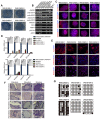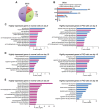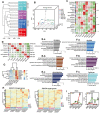Aberrant transcriptional networks in step-wise neurogenesis of paroxysmal kinesigenic dyskinesia-induced pluripotent stem cells
- PMID: 27449084
- PMCID: PMC5288209
- DOI: 10.18632/oncotarget.10680
Aberrant transcriptional networks in step-wise neurogenesis of paroxysmal kinesigenic dyskinesia-induced pluripotent stem cells
Abstract
Paroxysmal kinesigenic dyskinesia (PKD) is an episodic movement disorder with autosomal-dominant inheritance and marked variability in clinical manifestations.Proline-rich transmembrane protein 2 (PRRT2) has been identified as a causative gene of PKD, but the molecular mechanism underlying the pathogenesis of PKD still remains a mystery. The phenotypes and transcriptional patterns of the PKD disease need further clarification. Here, we report the generation and neural differentiation of iPSC lines from two familial PKD patients with c.487C>T (p. Gln163X) and c.573dupT (p. Gly192Trpfs*8) PRRT2 mutations, respectively. Notably, an extremely lower efficiency in neural conversion from PKD-iPSCs than control-iPSCs is observed by a step-wise neural differentiation method of dual inhibition of SMAD signaling. Moreover, we show the high expression level of PRRT2 throughout the human brain and the expression pattern of PRRT2 in other human tissues for the first time. To gain molecular insight into the development of the disease, we conduct global gene expression profiling of PKD cells at four different stages of neural induction and identify altered gene expression patterns, which peculiarly reflect dysregulated neural transcriptome signatures and a differentiation tendency to mesodermal development, in comparison to control-iPSCs. Additionally, functional and signaling pathway analyses indicate significantly different cell fate determination between PKD-iPSCs and control-iPSCs. Together, the establishment of PKD-specific in vitro models and the illustration of transcriptome features in PKD cells would certainly help us with better understanding of the defects in neural conversion as well as further investigations in the pathogenesis of the PKD disease.
Keywords: induced pluripotent stem cells (iPSCs); neural differentiation; paroxysmal kinesigenic dyskinesia (PKD); proline-rich transmembrane protein 2 (PRRT2); transcriptome analysis.
Conflict of interest statement
The authors declare no potential conflict of interest.
Figures






Similar articles
-
Urine-derived induced pluripotent stem cells as a modeling tool for paroxysmal kinesigenic dyskinesia.Biol Open. 2015 Nov 30;4(12):1744-52. doi: 10.1242/bio.013078. Biol Open. 2015. PMID: 26621826 Free PMC article.
-
Paroxysmal kinesigenic dyskinesia: Clinical and genetic analyses of 110 patients.Neurology. 2015 Nov 3;85(18):1546-53. doi: 10.1212/WNL.0000000000002079. Epub 2015 Oct 7. Neurology. 2015. PMID: 26446061
-
Generation of an induced pluripotent stem cell line (ZZUi022-A) from a paroxysmal kinesigenic dyskinesia individual carrying the PRRT2 gene mutation.Stem Cell Res. 2021 Mar;51:102210. doi: 10.1016/j.scr.2021.102210. Epub 2021 Jan 29. Stem Cell Res. 2021. PMID: 33550051
-
Recommendations for the diagnosis and treatment of paroxysmal kinesigenic dyskinesia: an expert consensus in China.Transl Neurodegener. 2021 Feb 16;10(1):7. doi: 10.1186/s40035-021-00231-8. Transl Neurodegener. 2021. PMID: 33588936 Free PMC article. Review.
-
PRRT2 mutations in a cohort of Chinese families with paroxysmal kinesigenic dyskinesia and genotype-phenotype correlation reanalysis in literatures.Int J Neurosci. 2018 Aug;128(8):751-760. doi: 10.1080/00207454.2017.1418345. Epub 2018 Jan 7. Int J Neurosci. 2018. PMID: 29285950 Review.
Cited by
-
Elderly-Onset Paroxysmal Kinesigenic Dyskinesia: A Case Report.Neurol Ther. 2022 Dec;11(4):1805-1811. doi: 10.1007/s40120-022-00405-0. Epub 2022 Sep 17. Neurol Ther. 2022. PMID: 36114926 Free PMC article.
-
PRRT2 controls neuronal excitability by negatively modulating Na+ channel 1.2/1.6 activity.Brain. 2018 Apr 1;141(4):1000-1016. doi: 10.1093/brain/awy051. Brain. 2018. PMID: 29554219 Free PMC article.
References
-
- Kertesz A. Paroxysmal kinesigenic choreoathetosis. An entity within the paroxysmal choreoathetosis syndrome. Description of 10 cases, including 1 autopsied. Neurology. 1967;17:680–690. - PubMed
-
- Goodenough DJ, Fariello RG, Annis BL, Chun RW. Familial and acquired paroxysmal dyskinesias. A proposed classification with delineation of clinical features. Arch Neurol. 1978;35:827–831. - PubMed
-
- Demirkiran M, Jankovic J. Paroxysmal dyskinesias: clinical features and classification. Ann Neurol. 1995;38:571–579. - PubMed
-
- Blakeley J, Jankovic J. Secondary paroxysmal dyskinesias. Mov Disord. 2002;17:726–734. - PubMed
-
- Lotze T, Jankovic J. Paroxysmal kinesigenic dyskinesias. Semin Pediatr Neurol. 2003;10:68–79. - PubMed
MeSH terms
Substances
Supplementary concepts
LinkOut - more resources
Full Text Sources
Other Literature Sources
Medical
Molecular Biology Databases

